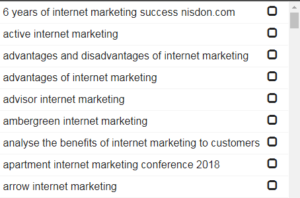Web analytics hides several secrets to boost online sales.
I have gone through several links. They comprise a lot of stuff. However, their content is valuable and informative. But, only an expert SEO or experienced digital marketer can execute it correctly. I needed an SEO assistant that I could harness myself. I got no leads even after six months of its development. The off-page SEO was on-going. But, inquiries were nil. Online traffic was still.
So, here is an abstract of what I did with the assistance of an experienced player of web analytics.
1.Technical SEO Auditing:
Indeed, SEO auditing is scanning of web errors. It was a puzzle for me initially. But gradually, I translated an expert’s guidance into executable steps. Let’s have a cursory glance over a technical SEO auditing checklist:
- Un-optimized internal and outbound links
- Missing tags like title tag, alt tags
- Missing meta-descriptions
- Broken links
- Detecting error pages
- Duplicate content
The aforementioned checklist helped me to come across web errors. Those on-page errors were a real challenge, but links, tags and content were sorted out. Still, my services did not appear the Google. Why?
- Dealing with Google indexing error:
The meta-descriptions lacked keywords that could target local SEO, like web development in the Gold Coast. This SEO technique instantly popped my website’s URLs in the Google Search Console. They all were indexed (although I had to wait for 48 hours to reflect those changes). Google spiders started including my webpages in searches. I started getting inquiries from my local area, i.e. Gold Coast.
But still, there are a few pages that did not appear in searches. It’s just because their URLs were broken links. I’ll disclose the way I tackled deleted pages and broken URLs in the ‘linking auditing’ section.
2.Traffic Auditing: Web traffic is a key performance indicator. The more it goes up, the more leads it counts. Now, my barrier was ‘how’. A little bit of browsing made me come across SEO tools, like Alexa, Semrush or Google Analytics.
SEO tools to audit traffic: There are many premium tools to scan the traffic report on your website. But, I turned to Alexa and Google Analytics.
- Alexa: As typed my site’s URL, Alexa popped out its global rank, rank in the continent, percentage of visitors, engagement indicators (via bounce rate, daily pageviews /visitor, daily time on site), search traffic (in %), top keywords along with percent of search traffic etc..
- Google Analytics: It’s the best SEO tool that I could ever have. Its segmentation of the online traffic is amazingly incredible. You effortlessly visualise the statistics of organic traffic, referrals, social traffic, traffic through ads, email marketing traffic, direct traffic, its sources, landing pages and demographics.
The traffic auditing highlighted the least and the most traffic generating landing pages. My SEO consultant saw it through analytical lens. He made strategies turn weak landing pages into a cash cow. I incorporated them with ad campaigns. Thereby, the spiking CTR gave a signal of boosting sales. He improvised internal, outbound page linking and included the most searchable keywords.
Subsequently, my target was linking and backlinks.
3.Linking Auditing: Linking connects leads underlying your online traffic. Traffic is a must to build good authority and page rank. Search engines take these two website indicators as a worthy to trust. Simply say, having good domain authority and page rank sends a message that the visitor can trust upon the site. Like a brand, the search engine ranking grounds up by winning the trust of the customers.
- Back-Linking Strategy:
My digital market assistant played with backlinks, which denote hyperlinks attracting traffic of other websites. However, he had been running offpage SEO activities. But, it missed the niche keywords. He scrolled up sales by earning through niche-based backlinks. This editing boosted his digital marketing efforts by:
- Sharing infographics with niche sites
- Guest blogging
- Blogging
- Article submission
- PPT/Video submission
- Document submission
- Testimonials
- Commenting
- Business listings
4. Keyword Auditing: If you use SEO tools, like Keyword Planner, Keywordtool.io, ahrefs and semrush, you get hundreds of ready-made keywords. When I typed ‘internet marketing’ in Keyword.io tool, this list of 580 keywords’ suggestion immediately popped down.

- Real-time Keyword Research Tools:
Before consulting with the SEO expert, I used to include the ready-made keywords. But, I was wrong. A blog inspired me to re-work on the keyword research. It taught me how to put myself in the shoes of customers to filter through niche topics. Several keywords tossed at the back of my mind when I submerged into this research on Google Trends, Live Chat conversation, Google Analytics and Google Coorelate. A flood of real-time queries relating to the niche is there. You just select a few ones to translate them into leads.
- Niche topics trigger sales inquiry:
Let’s say, you derive keywords ideas related to the rental car, as it’s your niche in Google. It instantly drops down the phrases like rental car in Delhi, rental car services, car on rent in New York etc.. Many out of these are highly searched, but your target audience doesn’t search likewise. They research according to their specific requirement.
So, you should stretch the phrases by specifying a few more elaborating words, such as a rental car for wedding in Delhi, rental car for business in Delhi, rental car for one day in Delhi and so on.
This idea certainly hits the bull’s eye. However, these are thinly searched. But, their conversion rate is higher than the high density keywords.
So, you should follow this formula: Niche topics+ Industry keywords+ Location
For example- From where can I get affordable rental car in New Delhi?
5. Social Media Auditing: You witness that almost every website integrates social icons like Facebook and Twitter. It’s a traffic building digital marketing technique. I also followed the footprints of SEO companies to generate leads. I shared blogs, articles, info graphics, and a pool of content relating to my niche. But, it was not enough.
I missed the social media auditing. Like web analytics, it is a key to unlock what’s working, what’s failing, what can be improved upon and a lot more.
- How does Facebook Insights help in attracting sales?
If you look into what Facebook Insights does, just run through it. You will see that demographics, engagement, likes, followers, page likes, post-reach, clicks, visits and weekly/monthly analysis of posts & people.
Its statistics coins several ideas on how to build trust. An intensive analysis revealed that unhappy clients were passing negative comments. It was adversely impacting my business. I politely responded to the negative comments, asking for apologies and addressing grievances. It quickly paid me off. Not only did I satisfy the client, but also he appreciated my efforts. His positive comments did mouth-to-mouth publicity for me.
It’s the best online sales generating trick that I drove out of the social media auditing.
6. Content Auditing: This auditing helps you to clean up things that don’t let your content pop on the top of SERPs. What my marketing assistant did to generate sale-oriented content, I’m sharing here:
- Checked, if the content has keywords that reflect my ideal customers’ intent
- Checked, if the keyword density is according to Google standard
- Checked, if title tag, header & body, URL and meta description carry keyword
- Checked the length (i.e. 160 characters) of meta-description matching the Google standard
- Checked, if the image alt tag is optimized
- Checked, if the content echoes similar topics
- Checked, if there is any duplicate content
- Checked, if there is any broken/dead link
- Fix broken links:
These points are critical and also, support search engine marketing efforts. My content auditing had a defect of broken links. They are the dead links because they are no longer accessible over the internet. When I researched about its reasons, I got to know these facts:
- Incorrect URL or typo error leads to broken links
- The outbound linked webpage is removed by the hosting website & ‘404 redirection’ is integrated.
- The website, where you had the outbound link, is disabled.
- The destination website has blocked the outbound links.
It’s a lead generating search engine optimization trick. The eCommerce or other websites fix this problem by redirecting the deleted pages, showing 404 -error. Remaining blindfolded to this error can take several leads away. So, fix them ASAP.
7. Market Intelligence: The web analysis strikes at the hidden intelligence. Let’s say, your website analysis spotted meager errors, but still it fails to attract leads. Traffic is, certainly, incoming. But, it’s popping out within 3 seconds. Why?
The experienced eyes of a web analyst can easily foresee its reasons. The content might lack niche topics. Or, its language might be difficult to understand. Or, the title tag might reflect client’s intent, but the content in the body doesn’t relate to.
It’s just an example. Likewise, there are many points, such as creating backlinks from the websites that differ from the niche. Leads indirectly relate to the intelligence. To maximize sales, you should work on analytics-driven intelligence.
8. Competitor analysis: Web analytics unfolds silos in the competitor analysis. It can be the best strategy to plan how to get ahead of the curve. I employed the premium version of Semrush analytics tool. It assisted me to churn what my competitors are capitalizing on. What I did through competitor analysis, I share with you:
- Determined their audience engagement tricks.
- Identified social strategies of competitors.
- Discovered their ranking posts to analyse loops in my content strategy.
- Discovered their backlinks to target them in the future.
- Identified new marketing and market trends.
9. Ad analysis: Google Adwords is a shortcut to pull traffic and gain visibility. I was aware about this fact. So, I turned to PPC ads while investing $100 in the beginning. However, adjusting its settings was a tricky job. So, I left it on my marketing assistant. He tussled with ad controls, negative keywords, feeding my profile and business address, A/B testing and device settings etc. besides bid settings.
- Relevant leads through negative keywords in ads
However, he missed the negative keywords. The Google Analytics clearly highlighted unnecessary clicks from the disinterested users. An intensive analysis threw light on the fact that the negative keywords were taking away the sales from my site. So, I integrated ‘jobs’ as a negative keyword from the targeting keyword “feed management in New Delhi”.
This is how Google is directed to hide my ad when the users type ‘feed management jobs in New Delhi’ or ‘jobs of feed management in New Delhi’. So, what clicks my ad won came from the genuine buyers.
10. App analysis: You can’t skip monitoring the performance of your native or web app. It’s noteworthy that more than 50 percent traffic hits from the mobile phones. So, you should keep an eye on the AMP analysis, app speed, screen flows, visual funnels, heatmaps, crash replays, syncing data and user list. Any hurdle in their smooth sailing can slash down the number of inquiries.
Wrap up:
Generating online sales is a mind game. Web analytics can help you to spotlight downsides. What it carries is the intelligence that can trigger sales at the pace that you have never imagined. A thorough observation lets you come across mind blowing strategies that your competitors are using for lead generation and reputation building. Just scan your web and app performance regularly to funnel out sales at outpace.

